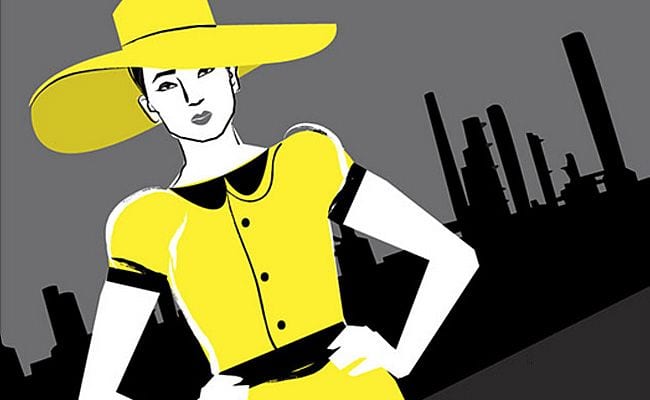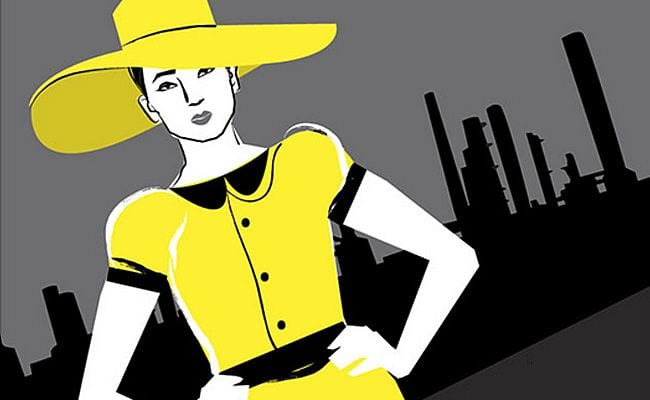
The fashion industry relies on outrage. There’s rarely a period of time when my Twitter feed doesn’t show a link or two about how the fashion industry is doing something horrible in order to market its products. This varies from the-always dependable use of blackface (so dependable that Buzzfeed—what else?—has a list of “15 Terrible Fashion Blackface Moments“) and yellowface.
Most recently, it was the use of sexual violence to sell sexual allure and glamour, as depicted in a recent fashion shoot in India that restaged the elements of a real-life gang-rape in Mumbai, an attack so vicious the woman died days later from her injuries. Her death might haunt the pictures, but the photographs—despite the photographer’s insistence that he wanted to get the “ball rolling” on something, though we’re not sure what— train the viewer’s eyes to gaze upon the alluring female body, adorned in lovely clothes.
Like the photographer’s defence, most of the other forms of defence from fashion industry insiders and creative personnel also follow a predictable script: no offense was intended, this is mere artistic expression, we are trying to raise awareness, etc. That this has long been a pattern for the fashion industry is the point—in this case, attention is all that’s needed to increase brand visibility or to further a photographer’s career. The idea is to generate the outrage, publish the pictures—by which point it’s too late for anything, really—then express “regret”, apologise, and carry on as usual.
The regret and the apologies are also a key part of the outrage cycle; it allows people to continue to invest in a personalised brand by assuming that it was a genuine mistake, or that it will not happen again. It allows the corporations that run the fashion industry to present a front of diversity and an illusion of “progress”—They are learning from their mistakes! They will do better next time!—all to ensure that sales don’t stop and profits don’t slow down.
In this sense, the fashion industry isn’t so different from the culture industry, and this is in large part what Tansy E. Hoskins attempts to show in her book, Stitched Up: The Anti-Capitalist Book of Fashion. It’s rare that a book’s content delivers exactly what the title promises, but in this case it does exactly that.
Published by Pluto Press, Hoskins’ book is tightly-contained and organised into ten neat chapters; the first third of the book focuses on the material conditions of economic production, while the second third explores the symbolic and representational aspects of the fashion industry and its attendant marketing and branding. The final section, meanwhile, looks at forms of resistance and reforms within the fashion industry, with the final chapter imagining a post-capitalist world and what might be its possible implications for fashion (and by extension, art and consumption).
“Ignoring social production leads to mystification of fashion”, Hoskins writes early on, and her introductory chapter drops us right in the middle of a wholesale market in Bangkok, describing how even in the periphery of the Western imperial core, cost-cutting is paramount—which is why clothes that are assembled in Bangkok are stitched by homeworkers living in the poorer parts of north Thailand.
Hoskins’ rigorous commitment to always bringing the conversation back to capitalism is at its best in these early chapters that document the production process of both couture fashion and fast fashion. “The apparel industry is the site of perpetual struggle between labour and capital”, she reminds us, drawing the reader’s attention to how rich countries relocate production to poorer countries in a bid to out-manoeuvre some of the labour gains made in the first world (these gains having come, again, at the expense of the countries at the periphery). As such, capitalism always relies on colonialism.
Hoskins describes her own interest in fashion, and the pleasure she receives from it, as part of the reason why she cannot pretend to be uninterested in the violence that is required to make what we wear. In doing so, she pries apart the easy liberalism that subtends the belief that the internet has democratised fashion, or that more diverse selfies on Tumblr is somehow making a change in forms of entrenched capitalist oppression enacted through differences in race and gender.
On a symbolic level, people are well aware that there are diverse bodies on this planet, that beauty comes in every shade and hue; yet capitalist gains are made by exploiting racial and sexual differences and selling it back to us. The chapter on “The Fashion Media” meticulously details how fashion bloggers or Tumblr users are picked out, not to destroy elitism or erase hierarchies, but to give lip service to democratisation while finding new ways to make a profit off competition and the illusion of scarcity.
Hoskins points out that access is already limited to a select group of people who are able to participate by means of access to technology and digital tools, plenty of free time and money with which to experiment with more clothes and make-up, a “studied personal appearance that conforms to accepted beauty standards”, and a politics that makes them amenable to furthering the interest of beauty and fashion brands i.e., the multinational corporations that run the whole gig. “Fashion blogs can therefore be seen as corporate PR disguised as fresh young opinions”, Hoskins writes. There is nothing wrong with this; the danger, however, is in assuming that these forms of representation and expression are enough to institute material changes.
If capitalism’s goal is to accumulate or die, then it becomes clear why the fashion industry, like any other industry, needs to constantly cannibalise what is available. In the chapters on race and gender and body acceptance, for example, Hoskins shows that incorporation of a few non-normative faces or body shapes is meant to constantly repurpose fashion’s goals to be seen as special, and it also serves to discipline wayward bodies and looks—If you play by our rules, you might get to be one of us, too.
In essence, it makes fashion experimentation a rigged game; it circulates attention as the reward for hours of labour and at the end of the day, poor brown women who make these clothes are no closer to living “the dream” as advertised in one glitzy fashion spread after another. In making “reality unpalatable”, as Hoskins writes, fashion attempts to normalise its gaze through the people it employs in its branding and media departments. These workers in metropolitan cities like New York and Paris enjoy their perks at the expense of the factory workers and seamstresses in South Asia, for example, but they are policed as symbols of the fashion industry and must adhere, bodily and aesthetically, to a set of unwritten rules.
Further, Hoskins traces the political affiliations of the founders of luxury brands how they are wedded to the ruling class, like Coco Chanel’s alignment with the Nazis (not forgetting Dior, Hugo Boss, and Louis Vuitton): “Fashion houses need the political and economic clout of a powerful country that can negotiate advantageous terms for its products and establish cultural hegemony for its ideas.” All this, Hoskins constantly reminds us, because of labour and the continued need for exploited labour to create surplus value.
“When art and such politics merge, we must reject the art”, says Hoskins, and while this is commendable it becomes somewhat perplexing to narrow it down to fashion. If Hoskins is keen to point out how capitalism is at root the problem in the fashion industry, then it goes to say that capitalism is bigger than the fashion industry and any forms of “resistance” within it cannot be expected to lead to change except through the dismantling of capitalist social relations. As such, sometimes the arguments in Hoskins’ book can appear to be circular.
However, that is only to be expected—she seems to be greatly influenced by the Marxist thinker John Berger, and while she lacks his scope and depth, this book must be understood as an attempt to shed the light on capitalist social relations through the lens of the fashion industry. Hoskins never wavers in her attempts to talk about the fashion industry as we know as a symptom of capitalism. While her arguments are extensively footnoted, and her writing style direct and readable, some of the more complex Marxist concepts are left unexplained for the sake of clarity and, one assumes, brevity.
While this book might serve as a great introduction for people who are new to anti-capitalist thinking, it will require a reader who is committed enough to learn more about capitalist social relations to follow through on those footnotes and read the books listed in her bibliography. But even demystifying capitalism on the most basic level is no small thing, and one hopes that this provides to be a good introduction to younger people, in particular, who are grappling with myriad hideous so-called ethical choices in the world we live in that ensures no one gets to enjoy anything without being directly or indirectly responsible for someone else’s exploitation.


![Call for Papers: All Things Reconsidered [MUSIC] May-August 2024](https://www.popmatters.com/wp-content/uploads/2024/04/all-things-reconsidered-call-music-may-2024-720x380.jpg)



